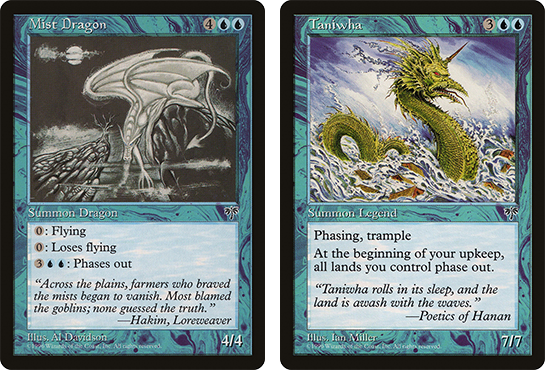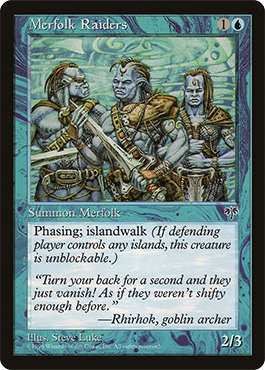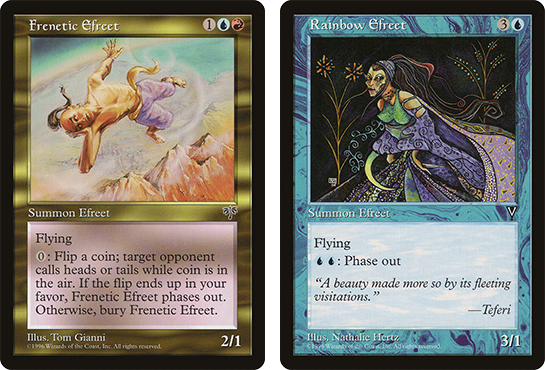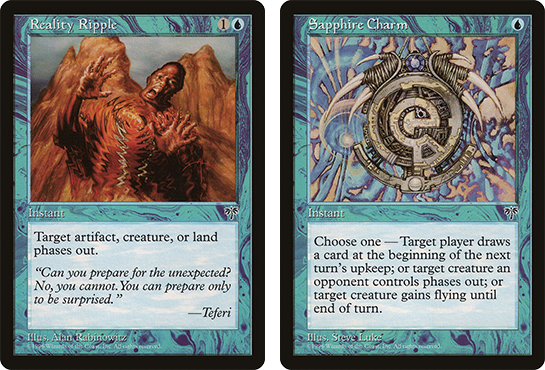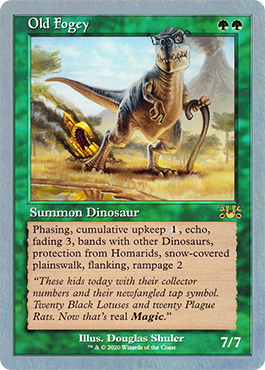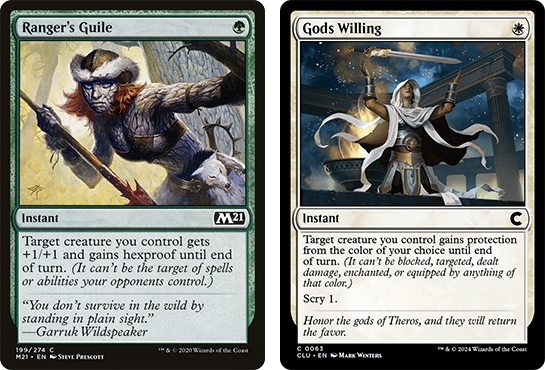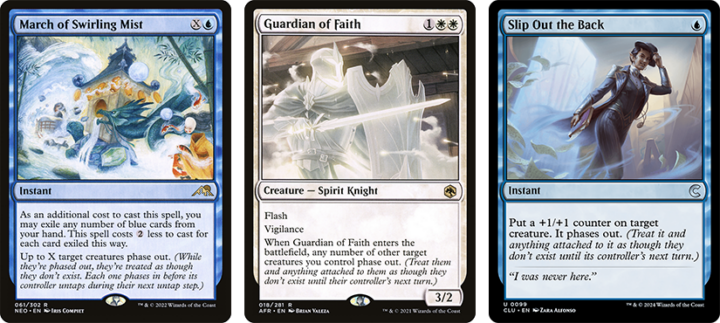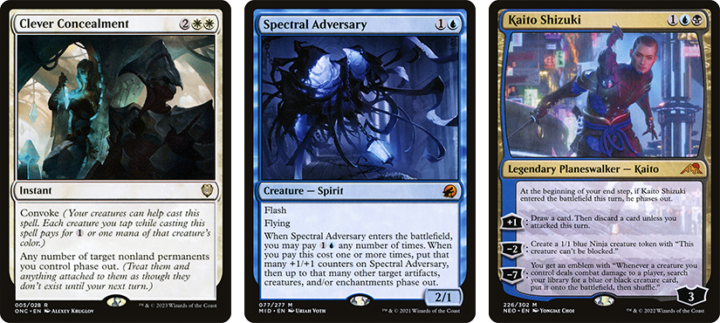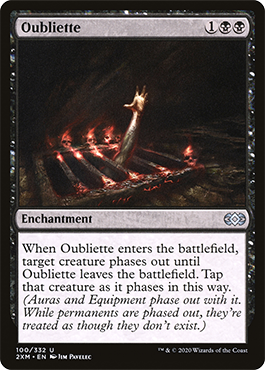For over two decades, phasing was a “dead” mechanic. It was a gruesome museum piece, maligned as an arch-example of archaic, confusing design. Even Time Spiral shied away from it when choosing old mechanics to highlight, despite it being a perfect fit for the time-manipulation themes of the block.
So then why is phasing suddenly making a comeback? Not just as a one-off nostalgic treat, but a core element of design in both Standard sets and supplemental products? Was phasing so ahead of its time that the rest of Magic is only now catching up? Or did it always have a key role to play – one which twenty years of designers simply overlooked?
AN ILL-FATED EXPERIMENT
Phasing certainly plays an important role in the lore of Magic, specifically the central plane of Dominaria. The mechanic was introduced in 1996’s Mirage block, which told the story of the planeswalker Teferi Akosa and how his experiments with time manipulation affected the continent of Jamuura.
This was an era where planeswalkers were immortal and all-powerful, and proud Teferi had suitably high ambitions. By “phasing” creatures in and out of the normal timeflow as needed, he figured he could make summoning and controlling them more mana-efficient. But the technique would never truly be perfected, creating as many problems for Teferi as it solved – eventually including the loss of his entire homeland, Zhalfir, when he tried to phase it out to protect it from Phyrexian invaders.
In that context, the original phasing mechanic did an excellent job of translating flavor into gameplay. Creatures with phasing offered amazing value in terms of stats vs. mana cost (at least compared to other creatures of the time). But the catch was, this great deal would only benefit the summoner half the time!
WHAT PHASES OUT…
Very few of the cards from Mirage block gave you control over when phasing happened. It was more like a polarity that flipped on your upkeep: everything that was phased out last turn phased in, and everything that had been phased in, phased out. Anything currently phased out was ignored by all other effects, rules and interactions, but when it came back it would still be the same object it was before: no summoning sickness, no ETB triggers, all the same choices and modes and modifications still applied.
It’s a perfect example of early Magic design – what we would later label a top-down approach which tries to match the lore as literally and intuitively as possible, even if it makes cards harder to understand at first glance.
The learning curve wasn’t exactly helped by the decision not to include any reminder text for phasing, forcing players to consult printed rulebooks from Mirage starter decks. Granted, Mirage was the very first time that Wizards tried using reminder text at all. But still it’s hard to fathom a card like Merfolk Raiders, whose entire rules text is “phasing; islandwalk” and still only finds room to explain the latter ability!
Now consider that Visions put phasing in close proximity with some of the all-time-best ETB triggers, and that the average player’s understanding of the rules (and to be fair, the rules themselves) were much more loose than in our present era. As you might expect, phasing quickly became infamous for causing confusion and arguments over rulings, forcing Wizards to publish repeated clarifications at a time when that meant waiting a month to print them in the next Duelist magazine.
Few players understood phasing, none of them enjoyed keeping track of it, and since it was obviously a drawback there was very little interest in playing these cards to begin with. The only exceptions were the cards which let the user control when they phased out, such as Frenetic Efreet or Rainbow Efreet, and those which used the mechanic offensively, like Reality Ripple and Sapphire Charm.
Ultimately, Wizards R&D came to regard phasing as a historic failure. When Mirage block concluded with Weatherlight in June of ‘97, it also marked the end of this short-lived experiment. Like Zhalfir itself, the phasing mechanic simply vanished into the mists of time, with no suggestion that it would ever return.
LOST IN TIME
It might sound like I’m being slightly over-dramatic with that last statement. After all, many of Magic’s keywords and abilities are associated with a singular set or block. Some might be revived when new sets revisit the same plane or theme, or appear in supplemental products which aren’t limited to a narrow mechanical palette. But both of those were rare occurrences during the time phasing was MIA. So how do we know Wizards weren’t just keeping phasing in their back pocket for an eventual Return to Jamuura?
Answer: because the design team told us so, loudly and repeatedly. Phasing wasn’t just a forgotten flash-in-the-pan; it was named alongside banding as a symbol of the bad old days, a quaint design error to either learn from or laugh at.
Lead designer Mark Rosewater rated it 9/10 on his influential “Storm Scale”, indicating a mechanic which “would require a minor miracle” to ever be used in a new Standard set. Phasing’s sole reappearance during this dark age was on the Un-set card Old Fogey – specifically to drive home the joke about long-dead mechanics that new generations of players wouldn’t recognize.
There was absolutely nothing to indicate that phasing, of all things, would ever again be considered a relevant or desirable part of the game. Wizards had come up with “exile, then return” effects (a.k.a. flicker) to fill the same conceptual space when a card needed to temporarily vanish.
Even the way phasing was written felt fundamentally outdated. The invention of unique rules terms (i.e. “phased out” vs. “exiled”) cuts off the potential for emergent interactions with other sets, while the vague description that phased permanents are “treated as if they don’t exist” was at odds with the much more careful and legal-ese approach to rules text which had developed over the 2000’s.
But history often appears cyclical over a long enough period. New generations reappraise the works of their elders; designs that were unfashionable become retro-chic, and everything old is now new again. Almost exactly twenty years on from its last appearance in Weatherlight, we were about to witness a very unexpected second coming.
… MUST PHASE BACK IN
By 2017, Magic was teetering on the cusp of its long-building Commander revolution. The format’s exploding popularity had forced players and designers alike to reconsider what kind of game Magic was meant to be, how and where it was played, and which mechanics were seen as relevant and valuable.
The role of creatures had also expanded significantly, with years of power creep driving equivalent upgrades in removal and eventually counter-removal like Ranger’s Guile or Gods Willing. Phasing’s replacement, flicker, was also used in this role on cards like Momentary Blink – but due to the increasing prominence of enters- and leaves-the-battlefield triggers, those cards often turned into over-balanced value engines or combo enablers.
Flicker also turned out to be a mechanic that ate up a lot of space in a card’s textbox, and the design team for Commander 2017 saw card space as a resource in ever-shorter supply. Wizards knew that they needed a simpler way to template cards with these abilities, and preferably one they could print at low mana costs without accidentally breaking every permanent with triggered abilities.
I’m not sure what other ideas might have been floated or tested out before the designers decided to pull phasing out of mothballs for a second run. Ultimately, the team agreed that phasing could still have a positive role to play, so long as the players had more control over when things phased out. Teferi’s Protection became their proof-of-concept and the flagbearer for everything phasing could become in the Magic of the future.
Even without changing the rules for phasing much, it turned out to have very relevant advantages in the modern Commander metagame. Counters, auras, and other modifications common to “voltron” commander decks will stay stuck to their creatures through phase-out and phase-in.
Defensive phase-outs like Teferi’s Protection also allow creatures to dodge boardwipes, edicts and other non-targeted removal, where many flicker effects simply return them to the battlefield in time to perish by the next spell you had been responding to on the stack.
The elegant brevity of “All permanents you control phase out” even left room for reminder text – atonement for at least one more original sin of the mechanic from 1996. Teferi’s Protection went on to achieve huge popularity as a best-in-class interactive spell, and in-game observation showed that phasing was probably the least-confusing effect on the whole card!
It did take another few years afterwards, but by 2021 we were officially seeing new cards with phasing show up over multiple standard sets. What was once thought “a minor miracle” was now reality, and this time it wouldn’t be a mere flash-in-the-pan. Wizards confirmed the mechanic had been designated “deciduous”, meaning that we should expect to see it show up intermittently to lend flavor to new sets.
Fittingly, it was Teferi, Master of Time which really announced phasing’s full arrival, with cards like Guardian of Faith, March of Swirling Mist, Slip Out the Back and Clever Concealment soon to follow.
THE RIGHT TOOL FOR THE JOB
I’m both amused and amazed at how perfectly phasing has slotted into the modern Magic metagame, as well as how little refinement it needed to do so! Designers clearly appreciate having the means to simply take a permanent “out of play” without moving zones, resetting its history as an object, or any of the other wacky rules implications you get with flicker effects.
The same lack of potential for interaction which was once seen as a flaw is now extremely useful, allowing designers to create more ambitious interactive spells without the risk of unintentionally breaking things. Furthermore, simply telling players to “ignore that until your next turn” is much, much more intuitive than explaining the vagaries of flickering, and there are very few situations where phasing effects need any more thought than that!
In hindsight, phasing emerges as a pretty great idea sabotaged by poor application and presentation in its original outings. Early Magic sets were obsessed with trying to design creatures around these weird, prohibitive drawbacks which almost never led to anything playable or fun. Phasing always had the potential to be more – Reality Ripple is a perfect blueprint for how the mechanic is being used in 2024, and the re-templating of Oubliette shows how it could even have improved cards from EARLIER sets.
But that bad first impression got it lumped in with a string of other early mechanical missteps, and it took the unique demands of Commander players and the design pressures from years of ETB power creep for phasing to finally get the second chance it deserved.

Tom’s fate was sealed in 7th grade when his friend lent him a pile of commons to play Magic. He quickly picked up Boros and Orzhov decks in Ravnica block and has remained a staunch white magician ever since. A fan of all Constructed formats, he enjoys studying the history of the tournament meta. He specializes in midrange decks, especially Death & Taxes and Martyr Proc. One day, he swears he will win an MCQ with Evershrike. Ask him how at @AWanderingBard, or watch him stream Magic at twitch.tv/TheWanderingBard.


